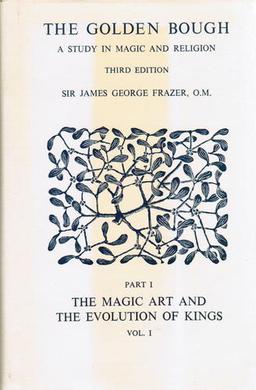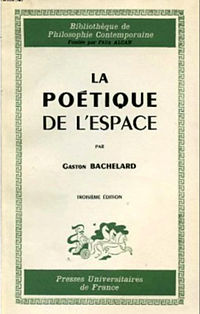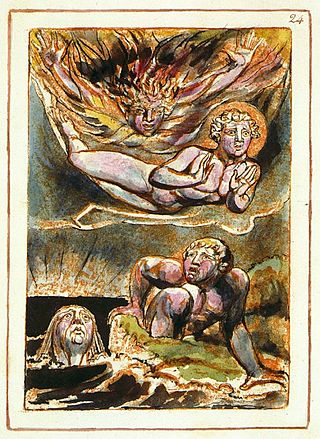
William Blake was an English poet, painter, and printmaker. Largely unrecognised during his life, Blake has become a seminal figure in the history of the poetry and visual art of the Romantic Age. What he called his "prophetic works" were said by 20th-century critic Northrop Frye to form "what is in proportion to its merits the least read body of poetry in the English language". While he lived in London his entire life, except for three years spent in Felpham, he produced a diverse and symbolically rich collection of works, which embraced the imagination as "the body of God", or "human existence itself".

The Golden Bough: A Study in Comparative Religion is a wide-ranging, comparative study of mythology and religion, written by the Scottish anthropologist Sir James George Frazer. The Golden Bough was first published in two volumes in 1890; in three volumes in 1900; and in twelve volumes in the third edition, published 1906–1915. It has also been published in several different one-volume abridgments. The work was for a wide literate audience raised on tales as told in such publications as Thomas Bulfinch's The Age of Fable, or Stories of Gods and Heroes (1855). The influence of The Golden Bough on contemporary European literature and thought has been substantial.
Herman Northrop Frye was a Canadian literary critic and literary theorist, considered one of the most influential of the 20th century.

Sexual Personae: Art and Decadence from Nefertiti to Emily Dickinson is a 1990 work about sexual decadence in Western literature and the visual arts by scholar Camille Paglia, in which she addresses major artists and writers such as Donatello, Sandro Botticelli, Leonardo da Vinci, Edmund Spenser, William Shakespeare, Johann Wolfgang von Goethe, Samuel Taylor Coleridge, Lord Byron, Emily Brontë, and Oscar Wilde. Following Friedrich Nietzsche, Paglia argues that the primary conflict in Western culture is between the binary forces of the Apollonian and Dionysian, Apollo being associated with order, symmetry, culture, rationality, and sky, and Dionysus with disorder, chaos, nature, emotion, and earth. The book became a bestseller, and was praised by numerous literary critics, although it also received critical reviews from numerous feminist scholars.

Leslie Aaron Fiedler was an American literary critic, known for his interest in mythography and his championing of genre fiction. His work incorporates the application of psychological theories to American literature. Fiedler's best known work is the book Love and Death in the American Novel (1960). A retrospective article on Leslie Fiedler in the New York Times Book Review in 1965 referred to Love and Death in the American Novel as "one of the great, essential books on the American imagination ... an accepted major work." This work views in depth both American literature and character from the time of the American Revolution to the present. From it, there emerges Fiedler's once scandalous—now increasingly accepted—judgement that American literature is incapable of dealing with adult sexuality and is pathologically obsessed with death.
Our great novelists, though experts on indignity and assault, on loneliness and terror, tend to avoid treating the passionate encounter of a man and a woman, which we expect at the center of a novel. Indeed, they rather shy away from permitting in their fictions the presence of any full-fledged, mature women, giving us instead monsters of virtue or bitchery, symbols of the rejection or fear of sexuality.

Milton is an epic poem by William Blake, written and illustrated between 1804 and 1810. Its hero is John Milton, who returns from Heaven and unites with the author to explore the relationship between living writers and their predecessors, and to undergo a mystical journey to correct his own spiritual errors.

The Poetics of Space is a 1958 book about architecture by the French philosopher Gaston Bachelard. The book is considered an important work about art. Commentators have compared Bachelard's views to those of the philosopher Martin Heidegger.

In the mythological writings of William Blake, Fuzon is the fourth and final son of Urizen, associated with the classical element of fire. In The Book of Ahania he fights Urizen for control of the world.

The prophetic books of the 18th-century English poet and artist William Blake are a series of lengthy, interrelated poetic works drawing upon Blake's own personal mythology. They have been described by 20th-century critic Northrop Frye as forming "what is in proportion to its merits the least read body of poetry in the English language". While Blake worked as a commercial illustrator, these books were ones that he produced, with his own engravings, as an extended and largely private project.

The Spectre is one aspect of the fourfold nature of the human psyche along with Humanity, Emanation and Shadow that William Blake used to explore his spiritual mythology throughout his poetry and art. As one of Blake's elements of the psyche, Spectre takes on symbolic meaning when referred to throughout his poems. According to professor Joseph Hogan, "Spectre functions to define individuals from others [...] When it is separated [from Emanation], it is reason, trying to define everything in terms of unchanging essences." Thus, according to Samuel Foster Damon, Spectre epitomizes "Reason separated from humanity" and "Self-centered selfhood" or, as Alexander S. Gourlay puts it, Spectre is "characterized by self-defensive rationalization".
Tiriel is the eponymous character in a poem by William Blake written c.1789, and considered the first of his prophetic books. The character of Tiriel is often interpreted as a foreshadowing of Urizen, representative of conventionality and conformity, and one of the major characters in Blake's as yet unrealised mythological system.

"Ah! Sun-flower" is an illustrated poem written by the English poet, painter and printmaker William Blake. It was published as part of his collection Songs of Experience in 1794. It is one of only four poems in Songs of Experience not found in the "Notebook".

Europe a Prophecy is a 1794 prophetic book by the British poet and illustrator William Blake. It is engraved on 18 plates, and survives in just nine known copies. It followed America a Prophecy of 1793.

Vala, or The Four Zoas is one of the uncompleted prophetic books by the English poet William Blake, begun in 1797. The eponymous main characters of the book are the Four Zoas, who were created by the fall of Albion in Blake's mythology. It consists of nine books, referred to as "nights". These outline the interactions of the Zoas, their fallen forms and their Emanations. Blake intended the book to be a summation of his mythic universe but, dissatisfied, he abandoned the effort in 1807, leaving the poem in a rough draft and its engraving unfinished. The text of the poem was first published, with only a small portion of the accompanying illustrations, in 1893, by the Irish poet W. B. Yeats and his collaborator, the English writer and poet Edwin John Ellis, in their three-volume book The Works of William Blake.

The Book of Los is a 1795 prophetic book by the English poet and painter William Blake. It exists in only one copy, now held by The British Museum. The book is related to the Book of Urizen and to the Continental prophecies; it is essentially a retelling of Urizen from the point of view of Los. The book has been described as a rewriting of the ancient myth of creation that equates fall with the loss of spiritual vision brought about by selfhood.

The continental prophecies is a group of illuminated books by William Blake that have been subject of numerous studies due to their recurrent and unorthodox use of political, literary and sexual metaphors. They consist of America, Europe and The Song of Los.

Blake: Prophet Against Empire: A Poet's Interpretation of the History of His Own Times is a 1954 biography by David V. Erdman whose subject is the life and work of English poet and painter William Blake.

Camille Anna Paglia is an American academic, social critic and feminist. Paglia was a professor at the University of the Arts in Philadelphia, Pennsylvania from 1984 until the university's closure in 2024. She is critical of many aspects of modern culture and is the author of Sexual Personae: Art and Decadence from Nefertiti to Emily Dickinson (1990) and other books. She is also a critic of contemporary American feminism and of post-structuralism, as well as a commentator on multiple aspects of American culture such as its visual art, music, and film history.
The Collected Works of Northrop Frye is a uniform scholarly edition of the writings of the 20th-century literary critic Northrop Frye. The series was published by the University of Toronto Press under the general editorship of Alvin A. Lee, with the first of its thirty volumes appearing in 1996 and the last appearing in 2012. Alongside Frye's established critical writings, interviews, and speeches, the Collected Works presents previously unpublished material, such as diaries, book drafts, and juvenilia, drawn from his archives at Victoria University, Toronto. The project was funded by various grants from the Michael G. DeGroote family through McMaster University, from the Social Sciences and Humanities Research Council of Canada, and from Victoria University, Toronto.

Biographical criticism is a form of literary criticism which analyzes a writer's biography to show the relationship between the author's life and their literary works. Biographical criticism is often associated with historical-biographical criticism, a critical method that "sees a literary work chiefly, if not exclusively, as a reflection of its author's life and times".

















